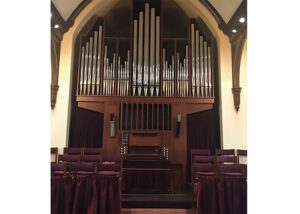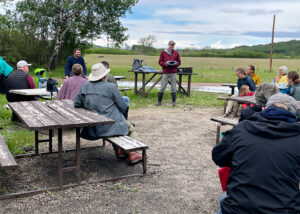This six-part series draws on Kara Carter’s PhD studies, for which she conducted five focus groups with Mennonite Church Eastern Canada pastors.
For periods of time during the pandemic, sanctuaries sat empty and congregations scattered, worshipping from home. As in-person gatherings and programming adapted, social media and technology became a vital tool to remain connected as the body of Christ.
As the church was unleashed and unbound from its four walls to be church in local neighbourhoods, many came to recognize that language can be a barrier to denominational missional identity. “Going to church” is a common phrase, meaning, going to a building, attending a program or social gathering.
The pandemic showed that what happens within the walls of the church building is an insufficient definition of church. The church is not the building but rather the people of God, commissioned by the resurrected Christ to further God’s mission in the world (Matthew 28:16-20).
New life has been unleashed as congregations reimagine their rich resource of buildings and properties. Intentional discernment facilitates space to dream, listen and consider current needs of the congregation and the community. An open posture challenges the approach of holding tightly to buildings that may no longer be meeting congregational needs as active participation and worship attendance decline.
One Mennonite Church Eastern Canada congregation has looked for ways to make the best use of their building and outdoor places. The congregation provides space for a local daycare program and educational programming for Low German speakers. A church house, leased to a denominational non-profit charitable organization, provides affordable housing to low-income households. The congregation dreams about creating a public park with their green space.
Another congregation is engaged in conversation about re-purposing their church property due to significant changes of congregational demographics. This conversation emerged when a homeless man made the church parking lot his home. The situation raised awareness related to poverty and the need for affordable housing in the community.
Amidst enlivened congregational conversations about reimagining or re-purposing buildings and properties, pastoral leaders also share stories that disclose barriers, constraints and the messiness of opening church buildings to the local community. One pastor noted that in their context there is a high level of perfectionism around care for the building. Those who have cared for and maintained the building for decades fear what will happen if the doors are opened wide. Things will be messy.
When a pastor launched a floor hockey ministry, he heard complaints that the floor was “getting scuffed.” Additionally, when a group of artisans used the building, some people said: “They’re making a mess. They’re not cleaning up.”
When a congregation gets tripped up about scuff marks on the gym floor or wear and tear of carpets, the church is unclear about the “why” of ministry and mission, including its primary calling and purpose. Amidst perfectionism and protectionism, it is crucial for congregations to wrestle with the question of who owns the building. If the congregation identifies as the building/property owner, the congregation identifies as landowner; if the community is the building/property owner, the congregation identifies as host; if God owns the building/property, the congregation identifies as stewards of God’s gift. How a congregation responds to the ownership question informs missional understandings, practice, hospitality and stewardship and uncovers our meaning-making stories.
For new Canadian congregations, building ownership provides security and stability. One new immigrant-founded congregation has grown to a three-language congregation. The building provides space for church plants, a local seniors drop-in ministry and a nursery school. Community gardens have been established. When congregational leadership asked to what extent this translates into more people attending worship, the pastor was quick to respond: “probably zero.” But church leaders are pleased with the community connections that have developed.
Another congregation regularly hosts a community seniors’ group that meets in the church sanctuary. At one event, the seniors moved pews around, set up tables and served food. The pastor reported that, “no one from the congregation freaked out” about it. The pastor admits that a few years earlier this would not have happened. This experience points toward a congregation’s response to the Spirit’s nudging, including releasing a tight grip on control and the need for neatness.
What is the Spirit of God saying to our faith communities about church properties that may no longer be meeting ministry needs or proving financially sustainable? As we look ahead, rather than back, what fruits may be produced as we respond to the Spirit’s disruption and inspiration?
Kara Carter is pastor of Wellesley Mennonite Church.







Leave a Reply
You must be logged in to post a comment.